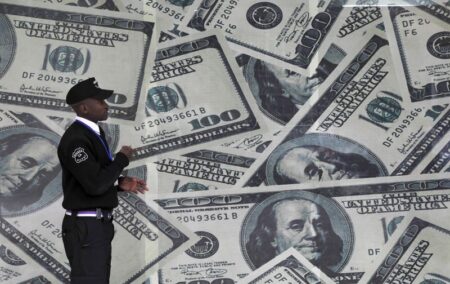By Gertrude Chavez-Dreyfuss
NEW YORK (Reuters) -The dollar was little changed on Friday after a rally in response to mixed data that suggested the world’s largest economy showed pockets of weakness but remained resilient overall.
The was flat at 102.43 in afternoon trading after hitting 103.10 in wake of the stronger-than-expected U.S. jobs report. That was the highest since mid-December.
For the week, the dollar gained 1.1%, on pace for its best weekly rise since mid-July.
The greenback earlier rallied after data showed the U.S. economy created 216,000 new jobs in December, exceeding the consensus forecast of 170,000. The unemployment rate was steady from November at 3.7%, compared with expectations of a rise to 3.8%, while average earnings rose 0.4% on a monthly basis, against forecasts of a 0.3% gain.
But that report was offset by data later in the session that indicated the U.S. services sector slumped last month.
The Institute for Supply Management (ISM) said its non-manufacturing index fell to 50.6 last month, the lowest reading since May, from 52.7 in November. The services industry accounts for more than two-thirds of the economy. Economists polled by Reuters had forecast the index little changed at 52.6.
More importantly, the ISM’s measure of services sector employment plunged to 43.3 last month, the lowest since July 2020 when the economy was reeling from the first wave of the pandemic. The index was at 50.7 in November.
The dollar fell after the ISM report, dropping to session lows below 102. The U.S. currency subsequently trimmed losses.
“At the end of the day, this is about market positioning,” said Marc Chandler, chief market strategist at Bannockburn Forex in New York.
“I see big outside days in the dollar index and I see net little changed on the day. The market lacks conviction and we should expect some broad consolidation maybe within today’s range for the next few days.”
Post-data, U.S. rate futures have priced in about five rate cuts of 25 basis points (bps) each for 2024, with the year-end fed funds rate expected at roughly 4% compared with the current level of 5.25%, according to LSEG’s rate probability app. Early this week, the market had factored in six rate declines.
U.S. rate futures traders have also factored in easing bets at the March Fed meeting to around 66%, largely unchanged from the odds seen over the last week.
Analysts said the jobs report suggested that the Federal Reserve would probably be in no rush to cut interest rates over the next few months. In the end, the futures market would likely come around closer to the Fed’s forecast of about 75 bps of rate cuts in 2024, they noted.
“Overall, I think the market is a bit ahead of itself here…I call March about a 50/50 meeting, and I wonder if we don’t stick around there for a little while as the data rolls in,” said Adam Button, chief currency analyst at ForexLive in Toronto.
“Inflation numbers will look really good by about June, but asking for that in March is aggressive. If the numbers start to turn I think the Fed isn’t going to hesitate, I think they’ve indicated that now, but this one jobs report – is this a game changer or not? I don’t think it’s a game changer.”
The market also shrugged off data showing U.S. factory orders increased more than expected in November, rising 2.6% after declining 3.4% in October.
In other currencies, the dollar was slightly higher against the yen at 144.655 . It rose as high as 145.98 yen, a three-week peak, after the payrolls data. On the week, the greenback advanced 2.2% versus the Japanese currency, on track for its best weekly performance since June 2022.
The euro, on the other hand, inched lower versus the dollar to $1.09405. Europe’s common currency fell 0.9% on the week, its largest weekly drop since early December and snapping a run of three weeks of increases.
Read the full article here











